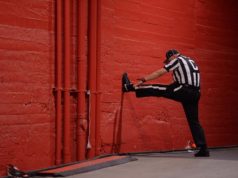With thousands of sporting events taking place each year ranging from youth leagues to the professional ranks, collisions between players and officials… and the resulting concussions, are bound to happen.
Sometimes an official sees it coming, sometimes he or she doesn’t. But even when an official is braced for impact, it often doesn’t help the individual avoid injury.
Atlantic Coast Conference football referee Ron Cherry saw the oncoming train — otherwise known as Southern Cal linebacker Michael Hutchings — at the last second in the Trojans’ late November game with Notre Dame. But he still couldn’t avoid injury when the latter accidentally ran into him following a quarterback sack. The contest continued with seven officials as Cherry was taken to a hospital and evaluated for a concussion.
Collision-concussion. The two can go hand-in-hand as concussion awareness has been ratcheted up in recent years with the primary focus on the athletes. But what about the officials on the field, court or diamond?
“Are there more risks today?” asked Rogers Redding, CFO national coordinator of football officials and NCAA Football Rules Committee secretary-rules editor. “There are probably somewhat greater risks, but officials today also are better conditioned than in years past so we haven’t noticed any uptick in injuries to officials.”
Are officials properly protecting themselves and taking the right steps when they show signs and symptoms of concussions? We’re smarter about concussions, but are we smart enough? Do too many officials take a macho approach and continue to officiate when they shouldn’t?
“It’s easy to get run over,” said Dr. John Kurt Frederick, ACO Medical Director in Texas. “I’m a (high school football) referee and I have umpires dodging players all the time. There are times when teams are trying to (use the umpire as a screen) and he gets knocked over. Those guys end up on the ground a fair amount.”
Frederick said an official who was contacted in such a way would merit examination. “You have to stop play, you have to check on him,” he said. “If you detect any signs of confusion, I think you have to put him on the sidelines for at least a play and I think you have to re-evaluate him.
“That may take time out of the game, that might be an administrative stoppage, whatever you want to call it, but I think we have to protect each other by using the same protocol.”Physical therapist Eric Edelman agreed. Edelman, who owns Peak Physical Therapy and Sports Performance in Hanover, Mass., is involved in post-concussion treatment for patients.
“I think anyone can be made aware of the warning signs (of concussions),” he said. “The problem is when you’re confused or concussed, a lot of times you don’t realize it. You have to understand this is a traumatic brain injury, so sometimes there could be enough confusion that you don’t even realize it. So it really behooves us to have people educated to be aware of the signs. Because the more people are aware of it, the better off we’ll be.”

When an incident such as the one involving Cherry occurs, people immediately hear about it or likely see a video of the collision. For instance, in basketball, officials can get tangled up with sideline photographers, camera operators and even cheerleaders. In fact, the NBA has tweaked its rules concerning photographers and camera operators to reduce the chances players and officials could get hurt.
NBA official Scott Wall injured his ankle when he became entangled with a sideline cameraman in January 2016 in Denver. The NBA Referees Association, citing the fact that teams attempt more three-point shots, forcing the referees to move farther away from the basket in order to get good angles, asked the league to act. As a result, the NBA banned cameramen on the sidelines during nationally televised games and ordered cameramen to move farther from the endline. Additionally, the standards were moved back to allow more space under the basket.
In an effort to limit collisions after several officials were injured, the NFL moved the umpire to the offensive backfield before the 2010 season. (The umpire returns to the defensive side of the line of scrimmage during the final two minutes of each half and on field goals and tries.)
Mike Pereira, former NFL vice president of officiating, said NFL umpires were knocked down more than 100 times during the 2009 season. Two umpires suffered concussions and three needed surgeries for knee and shoulder injuries.
Dr. Frederick echoed the concerns about the umpire position. “I like the fact that the mechanic of umpire has been changed a bit — at least here in Texas — where we let (the umpire) back up a little more,” he said. “We let (the umpire) get eight to 10 or even 12 yards off the ball so that there’s more of the play in front.
“I think that’s important,” Frederick continued. “I know we in the state have thought about moving the umpire over to the offensive side of the ball. Protecting the most vulnerable people would be our first step and I think the most vulnerable guy is the umpire. The referee can get hurt. The wings, too. But the guy in the middle is more likely to get injured. At some point, maybe it might be appropriate for the umpire to wear a helmet with the athletes getting bigger, stronger and faster.”
Neither high school nor college football mechanics have been altered in terms of moving the umpire to the offensive side of the ball.
“We considered moving the umpire a few years ago, but decided that giving up the umpire patrolling the middle was not a good idea,” Redding explained. “Our experience has been that there are no more injuries to the umpire than any other position.”

MLB has had to deal with another type of collision: a foul ball hitting an umpire’s mask at speeds up to and more than 100 miles an hour. About five years ago, MLB developed concussion protocol for players and umpires. The key components are mandatory baseline neuropsychological testing requirements during spring training; the establishment of a seven-day disabled list, designed to allow concussions to clear and prevent umpires from returning prematurely; and protocols for clearing a concussed umpire to return to activity.
“Major league umpires are subject to similar concussion clearance protocols as major league players,” explained Mike Teevan, vice president of communications for MLB.
“In any case where a concussion has been diagnosed, all symptoms must be resolved and the umpire must be cleared by Dr. Steven Erickson and Dr. Gary Green (MLB’s umpire medical consultant and medical director, respectively) before he is permitted to return to work.”
Teevan added that MLB is continually working to improve the safety standards of umpire masks. “On background, while no helmet is considered concussion-proof, our staff is leading a research group that is examining the effects of foul (balls), which might lead to improvements in equipment safety in the future,” he said.
But whether it’s improvements in equipment or changes to positioning, there is one constant in officials dealing with the aftermath of concussions: Don’t rush a return to action.
“If you suffered a concussion, the risk of having a second impact concussion is huge,” Edelman said. “As we get older, we heal slower. So the brain damage or the changes to our neurological system are that much greater and they take longer to recover from compared to a 15-year-old. That’s a big concern.”
Edelman added the macho factor among officials can kick in, too.
“The biggest thing that is starting to occur is the awareness of (concussions) and pulling somebody right out,” he added. “People can game the system, that’s still going to happen … testing still isn’t good enough to be able to prevent people from gaming the system and putting themselves back out there despite being at risk.
“But we’re certainly getting better at being able to identify the symptoms and say, ‘No, you’re out and you’re not coming back until you’ve had rest, done your physical therapy and you are deemed really fully recovered from this so you don’t risk second-impact syndrome.’”
(Editor’s note: Shortly after he was interviewed for this story, on Nov. 21, 2016, Dr. John Kurt Frederick died of a pulmonary embolism. He was 56.)
What's Your Call? Leave a Comment:
Note: This article is archival in nature. Rules, interpretations, mechanics, philosophies and other information may or may not be correct for the current year.
This article is the copyright of ©Referee Enterprises, Inc., and may not be republished in whole or in part online, in print or in any capacity without expressed written permission from Referee. The article is made available for educational use by individuals.


















